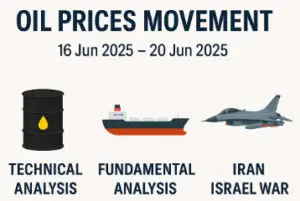Table of Contents
NASDAQ 100 (TECH100-USD)
In the wake of the June 6 U.S. nonfarm-payrolls report, which came in at 139,000 versus the 130,000 expected, the Nasdaq 100 shot up toward the 22,000 area. In that session, the index found solid buying interest on any dip toward 21,500, and by day’s end it was trading near 21,775, up roughly 1.22% for the session (fxempire.com). For the week of June 9–13, traders will be watching whether that momentum can carry the index above the 22,000 threshold.
-
Bullish Scenario (June 9–13): If buyers defend the 21,500 level early in the week and extend the post-NFP momentum, the Nasdaq could retest 22,000 by mid-week. A clean break above 22,000 may then open the door to 22,200–22,500 on the charts. The primary driver here would be continued confirmation that the Fed remains on pause (given steady labor data) and that megacap tech earnings hold up, fueling a two-tier market where large caps outperform. (fxempire.com)
-
Bearish/Risk-Off Scenario: Should any unexpected Fed speakers pivot hawkishly (or if headline risk from overseas roils sentiment), a dip back toward 21,500—and potentially 21,200 if sellers intensify—could unfold. That support zone around 21,500 is critical: a failure there would undermine the near-term uptrend. (fxempire.com)
Overall, assuming no major shocks, the range for June 9–13 is likely 21,500–22,000, with the bias skewed upward as long as 21,500 holds as support.
Dow Jones 30 (US30-USD)
On June 6, the Dow closed around 42,900–43,000, testing that level after the jobs report lifted equities. As noted, if the Dow can clear 43,000 decisively, the next technical targets are 43,500 and then 44,000, with buying on dips likely in the mid-42,000s (fxempire.com). Heading into June 9–13:
-
Bullish Scenario (June 9–13): Assuming U.S. Federal Reserve communications remain consistent with a pause—especially after the June 12–13 FOMC meeting—buyers could push the Dow above 43,000 by Tuesday or Wednesday. If momentum holds, 43,500 becomes a realistic mid-week target, with 44,000 in view toward Friday. The catalyst would be better-than-expected corporate earnings or any reassurance from Fed officials that rate cuts are still on the table later this year.
-
Bearish/Risk-Off Scenario: Conversely, if mid-week economic data (for example, softer-than-expected retail sales or a surprise uptick in jobless claims) shakes confidence, the Dow could slip back toward 42,500, with subsequent support near 42,200–42,000. That would indicate market participants are less willing to chase after highs without fresh positive catalysts. (fxempire.com)
All told, for June 9–13, watch the 42,800–43,500 zone. A weekly close above 43,000 would reinforce the bullish case, while repeated rejection there would suggest a pullback into the low-42,000s.
S&P 500 (SPX-USD)
As of June 6, the S&P 500 had reclaimed the 6,000 level—trading around 6,020 by late afternoon—after NFP data handily beat estimates. The near-term upside target remains 6,120, which was a prior resistance barrier in late May. Short-term pullbacks to 6,000 have been met with quick buying, suggesting strong technical support. Looking into the June 9–13 timeframe:
-
Bullish Scenario (June 9–13): If the S&P maintains its footing above 6,000 on Monday and any mid-week economic releases (like May retail sales or manufacturing PMIs) come in at least in line, the index could challenge 6,120 by Wednesday–Thursday. A clear break and daily close above 6,120 would open the door to 6,150–6,180 by week’s end, as traders lean into the narrative of a still-strong U.S. economy that is merely stalling Fed rate cuts rather than hiking.
-
Bearish/Risk-Off Scenario: Should market participants grow wary—perhaps due to a surprise rise in jobless claims, dovish-leaning Fed commentary that spooks financials, or geopolitical jitters—the S&P could slip back toward 5,980 by mid-week. Breaking below 5,980 would expose 5,950 and then 5,900 as potential supports, indicating the uptrend is pausing.
Therefore, expect a trading band of 5,980–6,120 during June 9–13, with a bullish tilt so long as 6,000 remains intact.
DAX (Germany, DE30)
After the European Central Bank delivered a 25 basis-point rate cut on June 5, the DAX climbed to an intraday record high of 24,479 before retreating to close around 24,277 on June 6. The market has been digesting both the rate cut and President Lagarde’s more hawkish communication—raising the possibility of a pause in July—so momentum is constructive but tempered. Over the week of June 9–13:
-
Bullish Scenario (June 9–13): If incoming German data on June 6 (exports falling only marginally, industrial production dropping less than forecast) undercuts fears of a slowdown, the DAX could retest 24,479 early in the week. A sustained break above that April 5 record could see 24,750 in focus by mid-week, and a stretch run toward 25,000 if investor confidence remains buoyed by dovish ECB rate-cut expectations. Additionally, any U.S. trade-EU positivity (e.g., progress in trade talks) could provide a catalyst to push the DAX above 24,500.
-
Bearish/Risk-Off Scenario: On the flip side, renewed hawkish tones from ECB speakers, or if June industrial output disappoints meaningfully (say, falls by more than the anticipated 1%), the DAX might pull back toward 24,000 by Tuesday. A break below 24,000 would then expose 23,750 and potentially 23,275 (the May 23 low), as sellers test whether the post-cut euphoria has faded.
In short, plan for a 24,000–24,500 range during June 9–13, with the door open to higher targets if German data and ECB communication remain supportive.
Hang Seng (Hong Kong)
Heading into June 5, the Hang Seng stood around 23,846, having rallied on housing and tech stock strength (e.g., Henderson Land up +5.38%, Alibaba +2.88%) amid optimism about a Trump-Xi call. That call was scheduled for early June, and markets were also eyeing the June 9 release of China’s inflation and trade data. As of June 5, the index was sitting just below the 24,000 mark. For June 9–13:
-
Bullish Scenario (June 9–13): If China’s June 9 trade data (e.g., exports and imports) come in close to or better than the modest expectations—exports down around 4% YoY, imports down 0.3% YoY—then risk appetite in Hong Kong could reignite, sending the Hang Seng back above 24,000. A daily close above 24,000 might propel the index toward its March high of 24,874 by mid-week, especially if Beijing hints at fresh stimulus. Moreover, any further easing of U.S.-China tensions following the Trump-Xi talk would reinforce a bullish tilt.
-
Bearish/Risk-Off Scenario: Conversely, if the trade data undershoot—say exports fall 6% instead of the 4% consensus, or price pressures (CPI) pick up unexpectedly—investor confidence could wane. A slide below 23,500 would then expose support at 23,000 and the 50-day EMA around 22,884. A break below 23,000, particularly on weak volumes, could open 22,500–22,300 into mid-week.
Overall, for June 9–13 the Hang Seng is likely to oscillate in 23,500–24,000, with a bullish lean if Chinese trade/inflation data surprise to the upside or if trade-war headlines cool.
Summary Table of Key Levels & Week Ahead Outlook
| Index | Support | Resistance | Mid-Week Target | Bearish Threshold | Primary Drivers |
|---|---|---|---|---|---|
| Nasdaq 100 | 21,500 | 22,000 | 22,200–22,500 | 21,200 | Fed pause expectations, tech earnings, NFP |
| Dow Jones 30 | 42,800 | 43,000 | 43,500–44,000 | 42,200 | Fed communications, corporate earnings |
| S&P 500 | 6,000 | 6,120 | 6,150–6,180 | 5,950 | Labor data, risk-on flows, breadth |
| DAX (DE30) | 24,000 | 24,479 | 24,750–25,000 | 23,750 | ECB messaging, German industrial/trade data |
| Hang Seng (HK) | 23,500 | 24,000 | 24,000–24,874 | 23,000 | US-China trade, China PMI/trade data, stimulus |
Each of these indices enters the week of June 9–13 on the back of supportive technical setups and lingering hopes for dovish central banks (Fed and ECB), but they face potential headwinds from upcoming economic releases (e.g., Chinese trade data on June 9, German industrial output data already priced in, U.S. Fed meeting on June 11–12). As long as key support levels hold (Nasdaq 21,500; Dow 42,800; S&P 6,000; DAX 24,000; Hang Seng 23,500), bulls will remain in control and likely push toward the resistance targets noted above. Conversely, any break below those springs of support would signal a short-term pause or pullback, testing lower bands.
By the end of the week, if none of the above makro or geopolitical factors shift markedly, it is reasonable to expect all five indices to trade higher within the ranges cited, building on the late-week rally seen after the June 6 U.S. jobs report and post-ECB rate decision.



